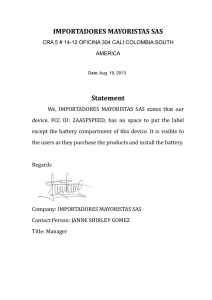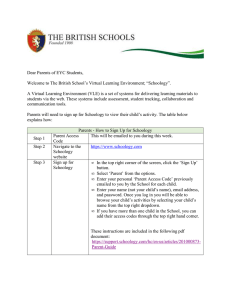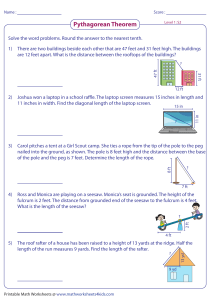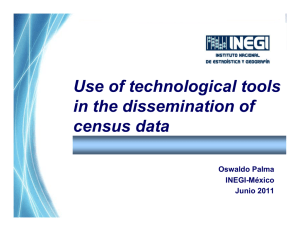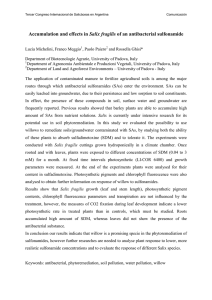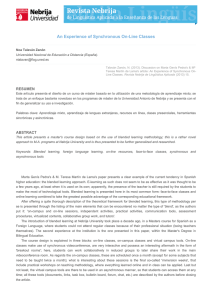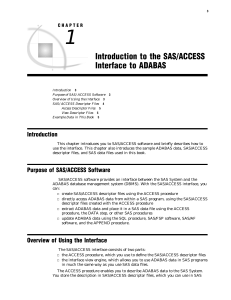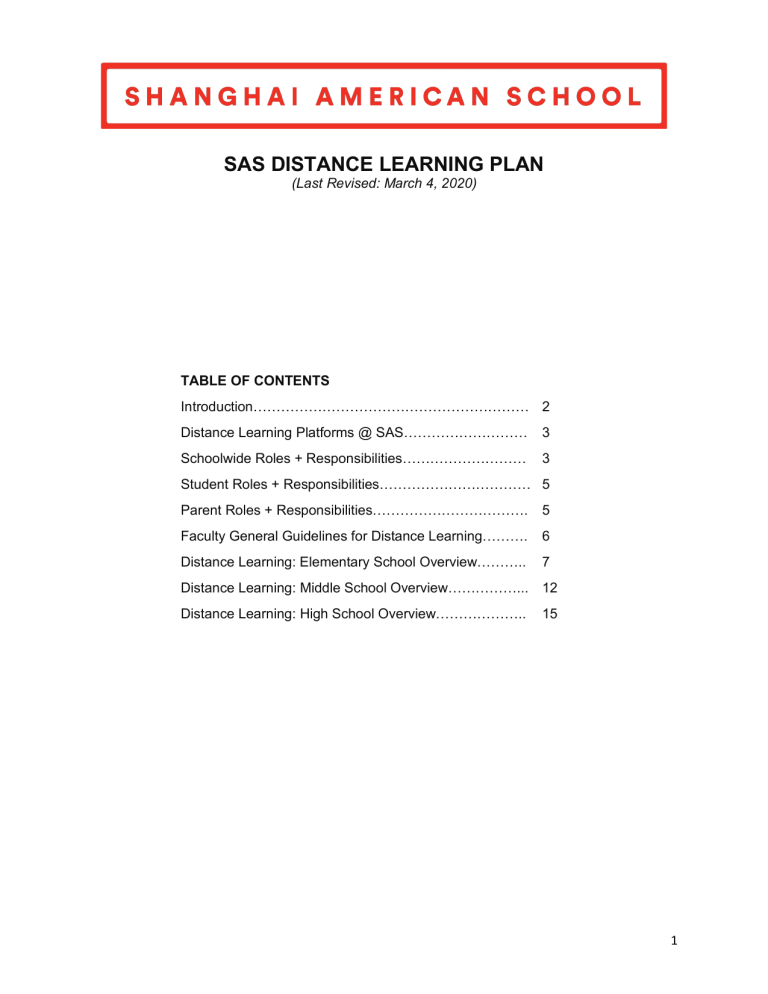
SAS DISTANCE LEARNING PLAN (Last Revised: March 4, 2020) TABLE OF CONTENTS Introduction…………………………………………………… 2 Distance Learning Platforms @ SAS……………………… 3 Schoolwide Roles + Responsibilities……………………… 3 Student Roles + Responsibilities…………………………… 5 Parent Roles + Responsibilities……………………………. 5 Faculty General Guidelines for Distance Learning………. 6 Distance Learning: Elementary School Overview……….. 7 Distance Learning: Middle School Overview……………... 12 Distance Learning: High School Overview……………….. 15 1 Introduction At Shanghai American School, we are proud to deliver our high-quality education and fulfill our mission in the context of our two Shanghai campuses. We are also proud that we will be able to do so under exceptional circumstances that may require partial or full campus closure. In such circumstances, our commitment is to provide an alternative means of education in the form of the SAS Distance Learning Plan. Distance Learning designates the experience students will have when school remains in session but when students are unable to physically attend school because of campus closure. While Distance Learning does replicate onsite learning, our teachers can deliver powerful instruction that allows students to meet expected standards in an online environment. The SAS Distance Learning experience aligns with our SAS Learning Principles. Our students will be empowered to make choices about how they reach clearly defined learning goals; be engaged in [online] collaboration to solve authentic problems; feel safe to take intellectual risks while persevering through challenges; be supported with modeling, differentiation, specific feedback, and opportunities for reflection and revision; and, will continue to be passionate, intrinsically motivated, and inspired to action. The success of our Distance Learning endeavor is a partnership and is dependent on careful planning by our dedicated faculty, appropriate student motivation and engagement, and strong parent support for this alternative mode of instruction. The result of such learning experiences will expand student academic progress and attend to student social and emotional well-being. While this is a time of uncertainty and challenge, it is also a time that provides us with unlimited opportunities to connect with ideas and with classmates who are scattered all over the world. Our faculty is prepared for this challenge. Our students are prepared for this challenge. Our parents are prepared for this challenge. SAS is prepared for this challenge. The purpose of this document is to outline how SAS will continue to offer a Blended Learning model, which includes both an Asynchronous Learning Environment as well as Synchronous, real-time engagements. An Asynchronous Learning Environment is a learning environment that does not require participants, teachers, and students to be online at the same time. Since faculty and students will be spread across the globe and a multitude of time zones, this is an essential part of the SAS Distance Learning Plan. Synchronous, real-time engagements are opportunities for students to participate in engagements with their teachers and classmates at an established time to allow for interactions in real time. A meta-analysis and review of Online Learning Studies from the US State Department of Education indicates that blends of online and face-to-face instruction, on average, had stronger learning outcomes than did face-to-face instruction alone. The following SAS Distance Learning Plan is designed to address the following scenario: • • • • • Asynchronous learning to ensure the opportunity to learn for all students in all time zones; Synchronous engagements to support learning and socio-emotional well-being of students through real-time engagements; Limited and/or variable online access to technology and internet for some students; Extended flexible timeline for Distance Learning delivery (at least, if not more than two weeks); and A commitment to monitoring and improvement of this plan and the student experience during the time of its implementation. SAS is committed to monitoring the SAS Distance Learning Plan and student experience. The tools used for monitoring may include, but are not limited to: 2 • • • Data on student engagement from digital learning platforms - Seesaw, Schoology, and Office 365 - provide tremendous data on student engagement. Feedback from students, parents, and teachers to help us understand how the plan is impacting student, family and teacher experiences, and to provide data on what improvements we might make going forward. Review of Schoology and Seesaw postings as a form of data collection to support teachers and students in aligning learning to the Distance Learning Plan. This SAS Distance Learning Plan will define the following: • • • Implementation Procedure to conduct school remotely until resumption of normal operations; Details the Expectations required of both teachers and families for the successful continuation of student learning and family communication; and, Divisional Plans that address developmentally appropriate and meaningful student learning experiences. Distance Learning Platforms at SAS The following Online Platforms support both Distance Learning and faculty/student/family collaboration to ensure a quality student learning experience when planning and delivering remotely: 1. SAS email and Schoology are the communication tools used to contact and communicate with SAS families, PreK-12. 2. Seesaw and Zoom are the online Distance Learning platform used in the Elementary School (PreK-5). 3. Schoology and SAS Office 365 tools (including Microsoft Teams) are the online Distance Learning platforms used in the Middle School (6-8) and High School (9-12). 4. WeChat, Skype, and SAS Office 365 tools (e.g., email, shared docs, OneNote, Microsoft Teams) are faculty online collaboration platforms for remote instructional planning. 5. Level Chinese is the main platform to support Chinese learning in an online learning environment. In addition to the above resources, we encourage faculty, students, and parents to contact [email protected] for any tech related question and to expect a response within 24 hours. This email account is managed by our Online Tech Support Team. Roles and Responsibilities (School) Leadership Team: • • • • Subject/Homeroo m Teachers: • EAL Teachers: • • • • • • • Develop divisional plans for distance learning. Communicate with faculty/staff and parents. Support faculty/staff and parents during Distance Learning. Ensure effective implementation of Distance Learning plan and accountability to student learning. Collaborate with colleagues to design Distance Learning experiences for students in accordance with divisional plans. Develop high-quality student learning experiences. Communicate with and provide timely feedback to students. Communicate with parents, as necessary. Support co-teachers in the development of high-quality student learning experiences in accordance with divisional plans. Curate and/or develop resources to support EAL students. Communicate with and provide timely feedback to students. Communicate with parents, as needed. 3 Learning Support Teachers: IB/AP Coordinators: Counselors: College Counselors: Coaches and Librarians: Teaching Assistants: Online Tech Support Team: • Partner with classroom teachers to accommodate the online learning curriculum they are providing to the learning support students on their caseload. • Communicate with all parents of students on their caseload the first week regarding the online learning plan and how they will co-plan with the teachers for the students to access the content of the distance learning lessons. • Recommend to parents and teachers other online learning platforms learning support students might be able to access at this time (e.g., IXL, RAZ kids, etc.). • Remain in contact with the IBO and the College Board (AP). • Communicate information from the IBO and the College Board to teachers, parents and students, as it becomes available. • Create developmentally appropriate videos regarding selfregulation, anxiety and/or wellness strategies that students can practice during this time of Distance Learning. • Create counseling lessons that students could complete “at home” based on the current curriculum. • Provide developmentally appropriate “blog-type” statement/s that include resources regarding anxiety, isolation, health and wellbeing particular to grade level(s). • Respond to counseling needs of students, as needed. • Ensure continuity of the processing of student files for college applications. • Support school advocacy with colleges, College Board, IB and other external bodies to ensure campus closure and its effects are understood. • Curate resources for teachers to support the development of highquality online learning experiences for students. • Create screencasts, videos, podcasts or other how-to resources for teachers. • Support teachers in the development of Distance Learning experiences, as needed. • Provide support and assistance to assigned grade level and/or subject area teachers as requested. • Provide timely response to student, family, and faculty requests regarding technology issues. 4 Roles and Responsibilities (Students) Students: • Dedicate appropriate time to learning, comparable to a school day and/or as guided by your teacher/s. • Check appropriate online platforms for information on courses, assignments, resources daily. • Attend, as much as possible, the regular synchronous engagements offered by each of their teacher/s. • Identify a comfortable and quiet space to study/learn. • Engage in all learning posted with academic honesty. • Submit all assignments in accordance with provided timeline and/or due dates. • Ensure own social and emotional balance by keeping healthy habits. Questions related to: A course, an assignment, a resource A technology issue/request Any other issue related to distance learning Contact: Relevant teacher – use email or Schoology message [email protected] Divisional administration Roles and Responsibilities (Parents) Parents: Support their child/ren in their learning by: • Providing an environment conducive to learning (access to technology, safe and quiet space during daytime). • Engaging in conversations on posted materials, assignments. • Monitoring time spent engaging in online and offline learning, including variables like that of preferred learning times (morning, afternoon, evening). • Encouraging attendance, as much as possible, to the regular synchronous engagements offered by each of their child’s teacher/s. • Support emotional balance by providing ample room and time for reflection, physical activity, conversation, and play. Questions related to: A course, an assignment, a resource A technology issue/request Any other issue related to distance learning Contact: Relevant teacher – use email or Schoology message [email protected] Divisional administration 5 General Guidelines for Distance Learning (Faculty) When designing your online lessons and learning experiences, please consider the following: Feedback: • Timely feedback is essential to student learning; this is especially so in online learning environments when/where students are unable to ask questions as they normally would in classroom setting. • Clear communication regarding where/how students should ask questions and seek clarification specific to learning targets, task requirements, and/or deadlines (email, Schoology, document, ...). • Active monitoring of your email for questions and communications from students/families. • Avoiding, unless carefully scheduled and limited, real-time chats as “help” sessions for students as they are in different time zones. Offline work: • Avoid requiring printing. All tasks must be completed on a device or uploaded as a picture. • Consider including offline activities in your lessons such as reading, engaging in discussions with a family member or friend remotely, writing in a journal, taking pictures, and/or making a video. Work time: • Strictly follow the divisional guidelines for time and schedule. • Consider varying the activities you normally plan in a graduated way, from very different to slightly modified. • Offer alternative opportunities for reading, research, online discussions/peer-feedback, and producing written work. • Seek the support of colleagues and others who have specific interest and/or expertise in delivering online Distance Learning experiences. Deadlines: • Provide students ample time to complete assignments. More time than you would usually provide in class may be necessary for students. • Keep tasks simple and directions clear to make sure students understand what they are required to do. Bandwidth: • Consider the size of the files to be downloaded by students; students’ WIFI access may have limited bandwidth. • If you embed videos, keep the size of the files small and avoid HD quality. Files: • Try to post only PDF or Office 365 documents as they are universal and are often easier to convert. • Avoid email submissions. Consider requiring all submissions to take place through Schoology or as a shared document. 6 Distance Learning Elementary School Overview Schooling is always a partnership. In an online Distance Learning environment, especially so at the elementary level, this partnership becomes the champion of learning. Over the course of this Distance Learning time period, our faculty will partner with parents to engage students in experiences that stretch their understanding and expand how they approach new learning. Teachers will continue to carry forward their instrumental role in guiding, supporting, and challenging students to take on new responsibilities and to become excited about new learning. Our families will have options and sources for flexibility that will give them choice and ownership as the Distance Learning experience progresses. Teachers will communicate with parents through Schoology and will use Seesaw, along with other online subscriptions, to engage students in rich learning tasks. In addition, Chinese teachers will use Level Chinese to engage students in individualized learning. All Elementary School Teachers will also invite students to optional interactive synchronous lessons and activities using Zoom each week. Role of Parents As Elementary School students are still developing their independence, a teacher-parent partnership is necessary for students to engage in Distance Learning tasks and to access online resources. The designed learning tasks and activities will provide direction and support to families with the understanding that task completion depends on each individual families’ circumstances. We recognize that parents may have more than one child to guide, therefore we have framed the support for the learning experience within one day not exceed 1 hour of computer time; time that will both inform and help prepare the student to engage in the learning tasks that the teacher has designed on that given day. We ask parents for the following support: • Read the Schoology updates from your child’s teachers. • Increase your familiarity with Seesaw as our primary instructional tool: Seesaw is our primary platform for home learning during the campus closure. The Seesaw Class app and the Seesaw Family app are two platform applications our students and their families will rely on and will learn to appreciate. Your child’s homeroom teacher will provide detailed instructions regarding how students/parents can download the Seesaw Class app (or how to access Seesaw through a web browser, if using a PC) and retrieve the class QR code to scan and then download the Seesaw Class app. • View the Monday morning message on Seesaw with your child where their teacher will welcome you to a new week of learning and introduce the topics for the week. • Read home learning tasks and activities posted on Seesaw with your child. • Help your child log in to Zoom sessions for interactive lessons and activities with teachers and classmates. • Designate a place in your home or where you are temporarily located so your child can work independently on his/her assigned tasks and complete independent reading each day. • Email your child's classroom teacher if you or your child has questions and/or if your child needs extra help and support. Our faculty, although spread across different time zones, will be present on-line to help and support within 24 hours. 7 Planning Day – Monday, February 3 Monday, February 3 is a designated workday for all faculty and staff to collaborate with their teams remotely and to plan for Distance Learning. Our students’ Distance Learning experience begins on Tuesday, February 4. Elementary School Distance Learning Plan Content and Timing The first week of Distance Learning will focus on skill review and practice, along with developing new online learning routines. • All learning tasks for February 4-5 will be posted via Seesaw on Tuesday, February 4 at 8:00 a.m. (Shanghai time) and additional tasks added throughout the week. • Once learning tasks are posted in Seesaw, teachers will post on Schoology that new learning tasks/activities are available and will include/reference the corresponding Distance Learning Plan for their grade level as outlined below. The following weeks of Distance Learning will focus on developing new skills, knowledge, understandings, and concepts, as well as on review and practice. • All learning tasks for each week will be posted on Seesaw on the Monday at 8:00 a.m. (Shanghai time). • Once learning tasks are posted in Seesaw, teachers will post on Schoology that new learning tasks/activities are available and will include/reference the corresponding Distance Learning Plan for their grade level as outlined below. • Weekly optional synchronous Zoom sessions will be communicated through email with the login code for the session. Elementary School Distance Learning Plan Assessment & Progress Monitoring Teachers will monitor student progress through the activities that students engage in on Seesaw and other digital platforms. Teachers will provide daily, specific and constructive feedback for each student. Teachers will adjust lessons as needed to meet the learning needs of their students. Formative assessments administered will be included in the daily time guidelines for each subject area. Upon return to campus, a more formal one-on-one assessment will be administered to redesign units as needed and to provide more concrete data for reporting. Prekindergarten 3/4 The Distance Learning Plan in Prekindergarten will include a list of home learning activities, engagements or invitations parents can facilitate for their children. Learning Experience: At the beginning of each week, Homeroom Teachers will post a video on Seesaw to welcome their students and parents to the upcoming Distance Learning experience and will briefly explain the learning approach and focus for the week. Prekindergarten students and their families will participate in literacy, math and optional activities from Art, Music, PE and/or Library each day. Students will also be invited to participate in weekly optional interactive synchronous lessons and activities using Zoom. Learning Timeframe: Students are encouraged to engage in Distance Learning in the designed and described to take place within approximately one hour, with the understanding that activities that take place throughout the day are extensions of this hour (e.g., reading aloud, pretend play, investigations, writing, drawing). It is important to keep in mind that the 8 quality of this experience is most closely associated with how deeply the child is connecting to the experience. This level of engagement need not take a lot of time; it does, however, take care and intent. Learning Specifics: This purpose of this document is to provide an overview of the experience. More specific details will be shared by Divisional Leadership in the weekly Schoology post on Sunday, February 2 and by teachers beginning Tuesday, February 4. Approximate Time per Day 20 minutes 20 minutes Limitless– Art, Music and PE Ideas from your Specialist Teachers Subject Area Literacy: Reading and/or Writing (with connections to Science/Social Studies content as appropriate) Math Activities Looking at books and reading aloud to your child is something we would always suggest, and below are a list of limitless ideas that will serve as resources to help keep your child’s mind engaged these next few weeks. We encourage you to spend time as a family in learning that often feel like play. For example, play a game the requires math/strategy/critical thinking. Something as simple as a Tic-Tac-Toe game turned into a graph of wins/losses/draws is one such simple idea. Many more ideas from our specialist teachers will be shared and updated. Kindergarten to Grade 2 The Distance Learning plan in Kindergarten to Second Grade will include home learning engagements and/or activities that parents can assist their child in completing. Learning Experience: At the beginning of each week, Homeroom Teachers will post a video on Seesaw to welcome and to explain the learning approach and focus for the week. Kindergarten to Second Grade students will participate in literacy (reading/writing), math and optional activities from Art, Music, PE and/or Library each day. A variety of tasks will be included, and some learning tasks may include other online platforms (e.g. Level Chinese, Reflex, iXL, Freckle, BrainPop, RazKids, O365, Khan Academy). If another online platform is required, teachers will share specific instructions for parents to access the platform. Students will also be invited to participate in weekly optional interactive synchronous lessons and activities using Zoom. Learning Timeframe: The described learning is designed to take approximately one and a half hours/day. It is important to observe your child as he/she engages in the task and to use this observation to help guide your support. We also and always encourage you to explore familiar experiences and activities like that of reading for pleasure, journal writing, and play to extend and enhance your child’s learning. Learning Specifics: This purpose of this document is to provide an overview of the student learning experience. More specific details will be shared by Divisional Leadership in the weekly Schoology post on Sunday, February 2 and by teachers beginning Tuesday, February 4. 9 Approximate Time per Day 20-25 minutes 20-25 minutes 20-25 minutes Limitless – Art, Music and PE and Library Ideas from your Specialist Teachers Subject Area Literacy: Reading and/or Writing (with connections to Science/Social Studies content as appropriate) Math Chinese - Level Chinese Looking at books and reading aloud to your child is something we always recommend and below is a list of ideas that will serve as resources to engage your child and encourage progress. We encourage you to spend as much family time as possible engaged in activities that bring meaning and joy together. For example, play a game the requires math/strategy/critical thinking. Something as simple as a Tic-Tac-Toe game being turned into a graph of wins/losses/draws is one such simple idea. More ideas from our specialist teachers will be shared and updated. Grade 3 to Grade 5 The Distance Learning Plan for Third to Fifth Grade will include home learning engagements and/or activities that parents can assist their child in understanding for independent completion. Learning Experience: At the beginning of each week, Homeroom Teachers will post a video on Seesaw to welcome their students and parents and to briefly explain the learning approach and focus for the week. Third to Fifth Grade students will participate in reading, writing, math and optional activities from Art, Music, PE and/or Library each day. Students will have the opportunity to integrate content areas in meaningful ways. A variety of tasks will be included, and some may include other online platforms (e.g. Level Chinese, Reflex, iXL, Freckle, BrainPop, RazKids, O365, Khan Academy). If another platform is used as part of an activity, teachers will share specific instructions for parents to access the platform. Students will also be invited to participate in weekly optional interactive synchronous lessons and activities using Zoom. Learning Timeframe: Students are encouraged to engage in Distance Learning in the designed and described ways for approximately two hours/day. The quality of this experience is most closely associated with how deeply the child is connecting to the experience. Over the course of this timeframe, students will engage with varying degrees of independence. The more challenging the task, the more support that might be required. Encourage your child to seek support while allowing your child to accept responsibility and take on challenges with increasing independence. Learning Specifics: The purpose of this document is to provide an overview of the student learning experience. More specific details will be shared by Divisional Leadership in the weekly Schoology post on Sunday, February 2 and by teachers beginning Tuesday, February 4. Approximate Time per Day 25-30 minutes 25-30 minutes 25-30 minutes 25-30 minutes 20 minutes Subject Area Reading (with connections to Science/Social Studies content as appropriate) Writing (with connections to Science/Social Studies content as appropriate) Math Chinese - Level Chinese Grade 5 Students: Strings/Band Instrument Practice (if possible) 10 Limitless – Art, Music and PE and Library Ideas from your Specialist Teachers Being immersed into a good book is something we always value and is something we encourage you and your child engage in frequently over the next few weeks. Below are a list of resources to help keep your child’s mind remain engaged these next few weeks, yet feel free to go beyond this list. Playing a game that requires strategy and taking on something as simple as a Tic-Tac-Toe and turning it into a graph of frequency/probability is one idea that could spawn other ideas. More ideas from our specialist teachers will be shared and updated. 11 Distance Learning Middle School Overview We know that learning takes on many different forms and can take place in many different settings. Our upcoming Distance Learning experience is the very type of experience that our middle school students are prepared to take on and to grow from, independently, with their peers, and even with their families. Over the course of this campus closure, students will be invited to engage in learning experiences that will stretch their thinking and will encourage new ways of doing in each of their classes, even though they will not be physically present on campus. Students will learn through a blended learning model, which includes asynchronous learning as well as synchronous, realtime interactive sessions with their teachers and classmates. Each of these learning experiences may be followed up with appropriate homework or a formative/summative assessment to confirm that the students have engaged appropriately with the content and that their understanding of the content supports their progress towards the identified target standards. The clear goal for these days is to be analogous to the students’ experiences on typical days at school: to interact, to engage, to grow, and, ultimately, to learn. Role of Parents As Middle School students are still developing their independence, a teacher-parent partnership is necessary for students to engage in Distance Learning tasks and, in some cases, to access on-line resources. The learning tasks and activities provide direction and support to families. We recognize that parents may have more than one child to guide, therefore we have framed the learning experience to require minimal parent involvement. As a parent of Middle School students, we ask you for the following support: • Monitor Schoology updates and be sure to check in with your child daily about the distance learning tasks, activities and assessments they are working on. • Designate a place where your child will work independently on his/her assigned tasks. • Ask your child to provide a brief summary of the learning he/she is engaging in for each class to ensure his/her understanding of the content and of the process they are being asked to engage in to demonstrate their learning. • Monitor your child’s deadline calendar and support them in submitting assignments according to the established deadlines. • Remind your child to email his/her teachers if your child or you have questions or if you need extra help and support. Our faculty, although spread across different time zones, will be on hand to help and support within 24 hours. Planning Day – February 3 Monday, February 3 is a designated workday for all faculty and staff to collaborate with their teams remotely and to plan for Distance Learning. Our students’ Distance Learning experience begins on Tuesday, February 4. 12 Middle School Distance Learning Plan Content and Timing: The Distance Learning Plan in Middle School will include engaging experiences for each scheduled class students have on their regular school schedule for that day. With several lessons to engage in each day, teachers will account for the increased demand that will be required of students as they are engaging in this type of independent distance learning. Students will have multiple activities within the timeframe of a regular class. Teachers will provide guidance specific to the amount of time activities/assignments might require. This will include time spent on accessing content, as well as completing work. Students will also have off-screen tasks that are designed to engage the middle school learner and attend to middle school needs. Follow up homework or flipped classroom work may be expected in addition to the dedicated learning time for each class. Flipped classroom work is work assigned that requires students to fully and actively engage in the content independently and then reflect, summarize, and/or demonstrate newfound understandings of the content within a more collaborative online setting. To maintain consistency with on-campus learning, faculty who teach the same courses will plan Distance Learning collaboratively to ensure students have comparable experiences. Asynchronous Interactions: • Teachers will communicate student learning expectations, provide resources, collect assignments, and provide feedback through Schoology and Office 365. • Students will have daily Learning Target(s) in each subject area for their scheduled day (A/B). • Schoology pages will be updated for every lesson. Lesson updates will be ready for access by 8:00 a.m. (Shanghai time) the day of the lesson. When a learning experience includes a project or extended application of learning over multiple days, lesson updates will be posted for multiple upcoming sessions. Lessons will include: o A brief update referencing the daily learning target(s) for the lesson and directing students to the materials page to access resources/assignments, etc. This brief update will ensure: § students know what learning they need to accomplish for that day. § continuity of learning that is clearly connected to their learning in the prior class and will connect to the learning in the upcoming class. o A written explanation and/or recorded video/screencast (5 min. max. per lesson) to introduce, explain tasks, or provide instruction for each lesson. o A method of interaction such as: § Discussion forums § Office 365 tools or Schoology to provide feedback on student work ○ Digital/scanned resources, assignments, etc. • If students are required to engage in a project or extended application of learning, the project will be broken down into smaller actions/outcomes with deliverables/check-ins for each lesson. • Teachers will respond to student and parent e-mails/questions within 24 hours. • No sites requiring VPN will be used as a resource. Synchronous Interactions: • Students will engage in synchronous, or real-time, engagement with their teachers and classmates using use Microsoft Teams. • Teachers will engage in real-time with students in the following ways: 13 o o o Individual: Students request help by making appointments with their teachers or counselors on an agreed time. Scheduled Office Hours: Students can join office hours to ask questions or discuss learning with their teachers and classmates during specific times established by teachers. Mini Lessons: Students may participate in real time mini-lessons on specific topics during specific times established by teachers. Assessment and Progress Monitoring: • Non-graded formative and practice tasks: o Students will provide evidence of learning for each subject and lesson as a check for understanding. o Students will have the opportunity to provide feedback to each other. o Teachers will provide students with ongoing and regular feedback on their evidence of learning. • Graded summative tasks: o Students will participate in graded summative tasks at the end of a learning sequence. o Graded summative tasks that are performance-based will include a rubric and/or checklist shared with students as part of the task overview. o Teachers will provide feedback to students at regular checkpoints on tasks that extend over multiple lessons. o Students will have the opportunity to revise their tasks following a reflection and/or relearning task designed by the teachers when submitted work does not meet the Distance Learning Target. 14 Distance Learning High School Overview During campus closure, students will participate in meaningful learning experiences in each of their classes, even though they will not be physically present on campus. Distance Learning will follow the A/B rotation. The first day of distance learning, Tuesday, February 4, is an A day and will begin at 8:00 a.m. (Shanghai time). Students will engage with their A day classes that day and will not engage with their B day classes until Wednesday, February 5. IB & AP Specific Information: All members of our high school communities connected with externally-assessed courses – AP and IB teachers, students, and parents of AP and IB students – are aware of the additional pressures related to this unexpected transformation of in-school instructional time to distance learning. A team of SAS administrators, AP and IB Coordinators and college counselors has been in regular contact with officials from the College Board and the IB, and has developed plans to mitigate the impact of the current situation on students and their exams, as well as measuring possible future circumstances and our choices. For clarity, our understandings from communications with the College Board and the IB, together with our general recommendation and other possible options have been made available to AP and IB students. SAS will keep the community updated on this topic should our recommendations may change as the situation evolves. Role of Parents As a parent of High School students, we ask you for the following support: • Monitor Schoology updates and be sure to check in with your child daily about the distance learning tasks, activities and assessments they are working on. • Designate a place where your child will work independently on his/her assigned tasks. • Ask your child to provide a brief summary of the learning he/she is engaging in for each class to ensure their understanding of the content and of the process they are being asked to engage in to demonstrate their learning. • Ask your child about their deadline calendar and support them, as needed, in submitting assignments according to the established deadlines. • Remind your child to email his/her teachers if your child or you have questions or if you need extra help and support. Our faculty, although spread across different time zones, will be on hand to help and support within 24 hours. Planning Day – February 3 Monday, February 3, is a designated workday for all faculty and staff to collaborate with their teams remotely and to plan for Distance Learning. Our students’ Distance Learning experience begins on Tuesday, February 4. 15 High School Distance Learning Plan Content and Timing: • Students will be provided with a clear daily learning target for each class to ensure they know what learning they need to accomplish each day. The daily learning target will ensure continuity of learning that is clearly connected to their learning in prior classes and the classes following. • For courses with multiple sections, students will have the same Daily Learning Target and comparable learning experiences as students who have other teachers. • Total time for engagement in learning for each class, including reading, homework, and work towards long term assignments, should not exceed 75 minutes for noncollege level classes and 100 minutes for college level classes (AP & IB). Asynchronous Interactions: • Daily learning targets, lessons, and materials will be posted by 8:00 a.m. (Shanghai time). • Teachers will design learning in multiple tasks that complement each other in the development of understanding. Students should not engage in the same task for 75100 minutes continuously. • Teachers will provide a video and/or screencast to introduce the lesson and/or to provide instructions. • Teachers will provide an estimated duration for all learning activities. • Students may be expected to participate in discussion posts. • Deadlines will be flexible to accommodate student location and travel. • Resources needed will not require the use of VPN or streaming/download of files that are excessively large. • Teachers will clarify in advance how students should contact them if they need assistance and will respond within 24 hours to all student inquiries on weekdays. Synchronous Interactions: • Students will engage in synchronous, or real-time, engagement with their teachers and classmates using use Microsoft Teams. • Teachers will engage in real-time with students in the following ways: o Individual: Students may request help by making appointments with their teachers or counselors on an agreed time. o Scheduled Office Hours: Students can join office hours to ask questions or discuss learning with their teachers and classmates during specific times established by teachers. o Structured Synchronous Learning: Teachers or counselors may invite students to participate in a real time class meeting/lesson or in a small group work session. Assessment and Progress Monitoring: • Teachers will use a variety of assessment tasks to inform instruction, improve learning, and report on student achievement. • Teachers will design assessment instruments and create environments that assist students in making good choices related to issues of integrity. This could include: o Using an assessment monitoring system like lockdown browser or turnitin.com o Developing a class honor code; o Establishing clear expectations and guidelines for use of sources and collaboration and including them as part of the assessment task; o Post-assessment authentication through student reflection or teacher: student dialogue; or 16 Creating assessments that allow for student choice and development for how they will demonstrate learning. Non-graded formative and practice tasks: o Students must complete assigned non-graded assessments that provide a check for understanding. These may include (but are not limited to) discussions, forms, polls, reflections in OneNote Class Notebooks. o Teachers monitor student progress with ongoing and regular feedback. o Teachers will determine when summative assessments are administered based on the data collected from formative assessments. o Late submissions of formative assessments may not always receive feedback or comparably thorough feedback if additional opportunities for feedback related to the unit objectives are available, students are best served to focus on current assignments to move forward in the learning process, or the submission of late work is not in direct relation to the current unit of study or the nearest upcoming summative assessment. o Teachers will actively engage with the student, parents, counselor(s), learning specialist(s) (EAL or Learning Support Teachers) and Dean of Students/PDHS Vice Principal to support students who are not producing evidence of learning during a unit of study. Graded summative tasks: o Students must complete assigned graded assessments (30-45 minutes, no more than once each week per class) to measure progress against learning targets. These may include (but are not limited to) electronic portfolios, electronic quizzes/tests, writing assignments. o Graded summative tasks that are performance-based will include a rubric and/or other forms of scoring criteria shared with students as part of the task overview. o Clear instructions on where/how to turn in assignments will be provided to students. o Special arrangements may be made for specific types of assessments (e.g. oral exams, performance assessments, IB internal assessments, various aspects of course selection). Students will be informed if they must participate in such an assessment. o • • We thank you once again for your consistent and unwavering support as we work together to deliver continuity of learning during this challenging time. Do not hesitate to reach out to our administration and faculty if in need. – Your SAS Learning Community For inquiries regarding the SAS Distance Learning Plan, please contact Dr. Emmanuel Bonin, Deputy Head of School / Chief Academic Officer, at [email protected]. 17
